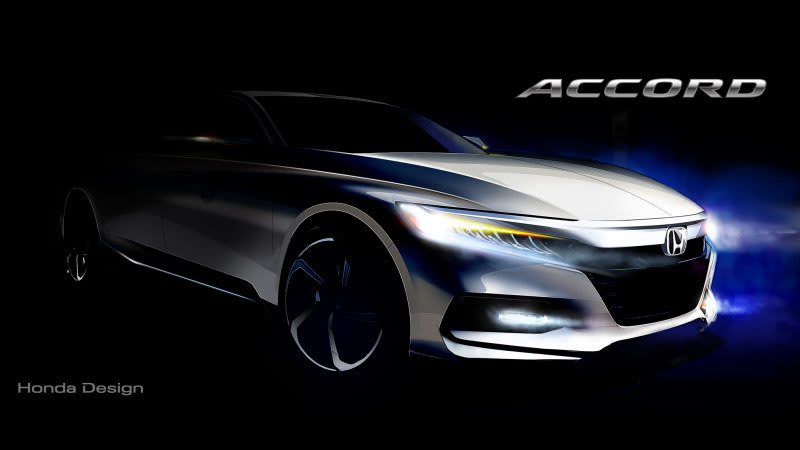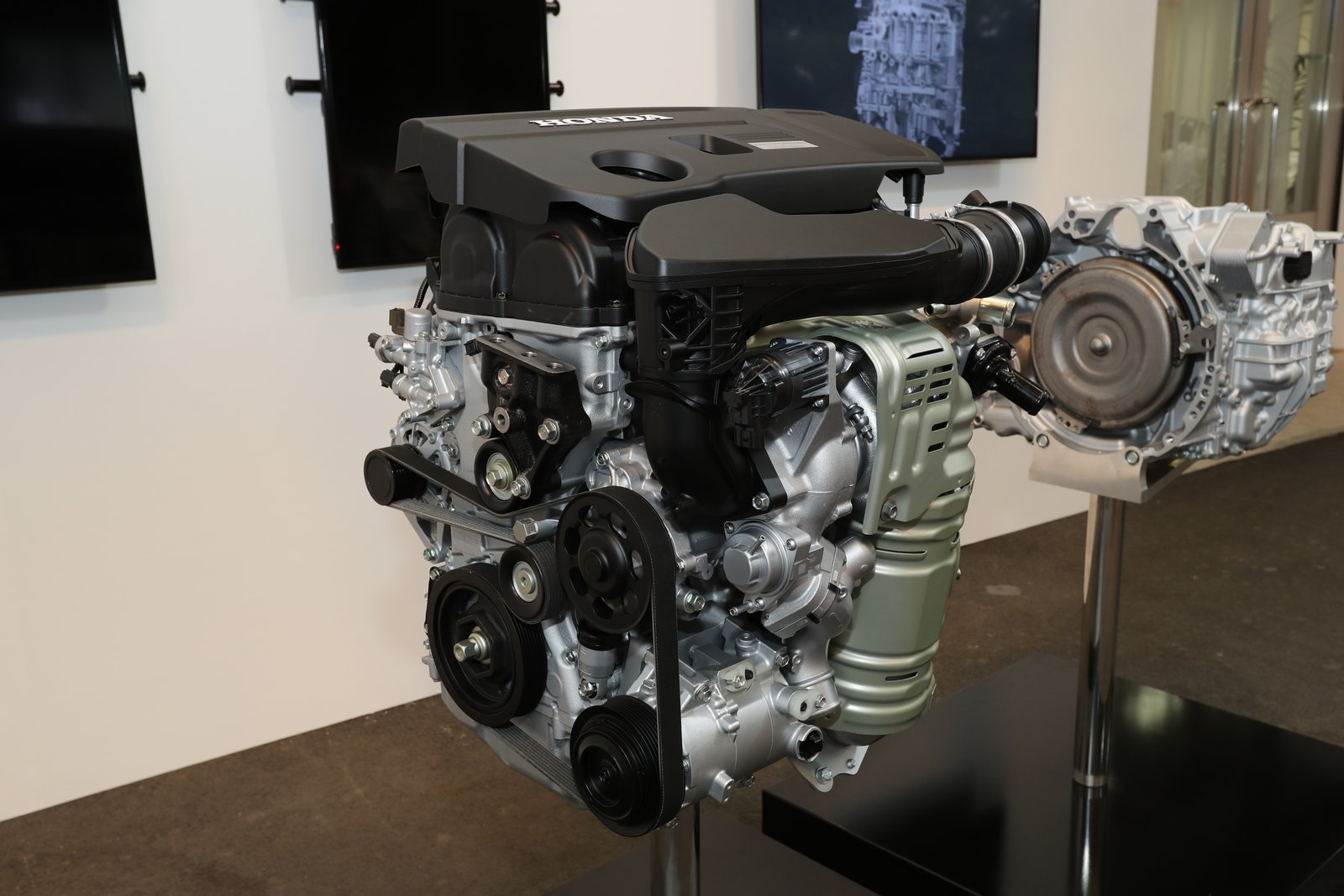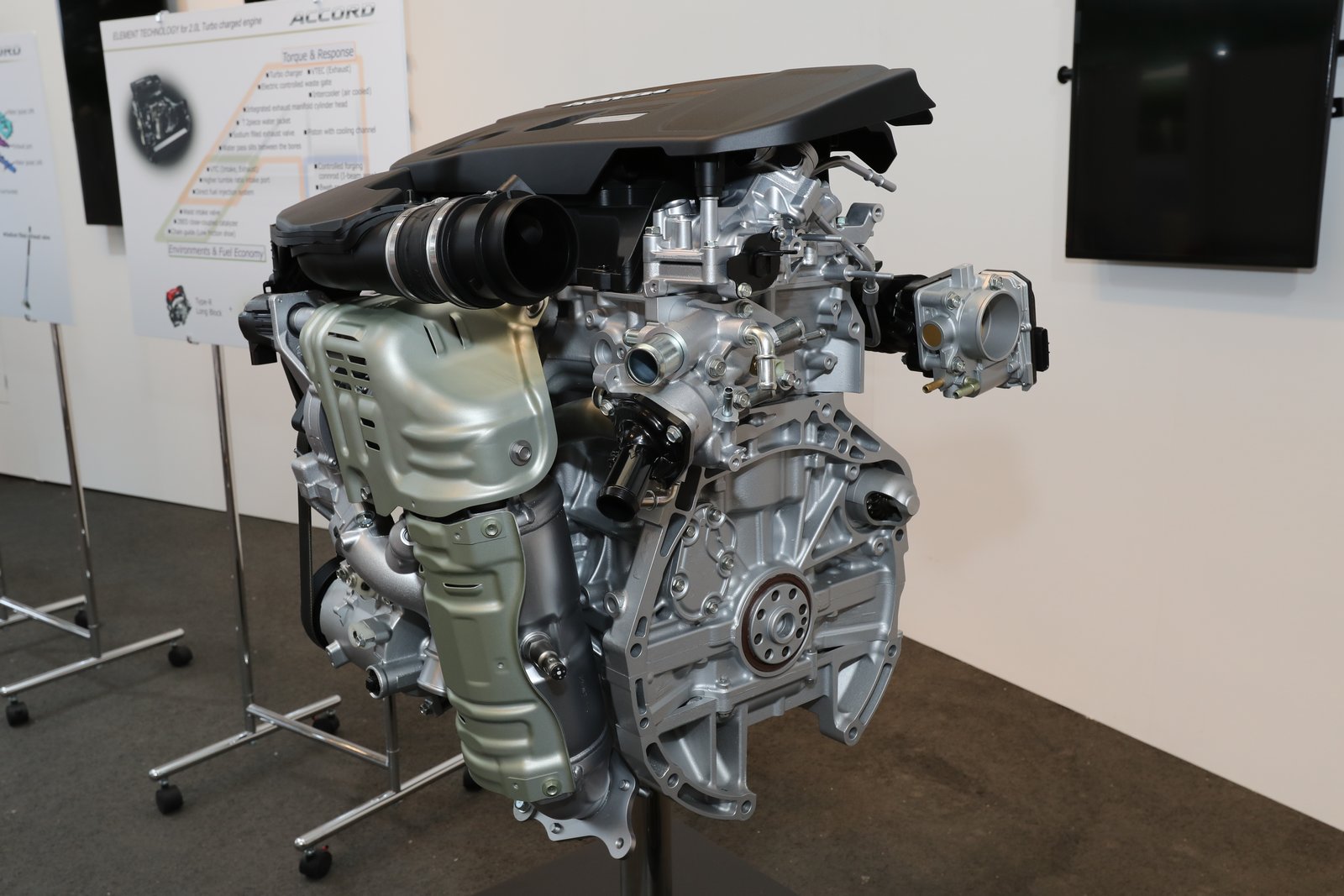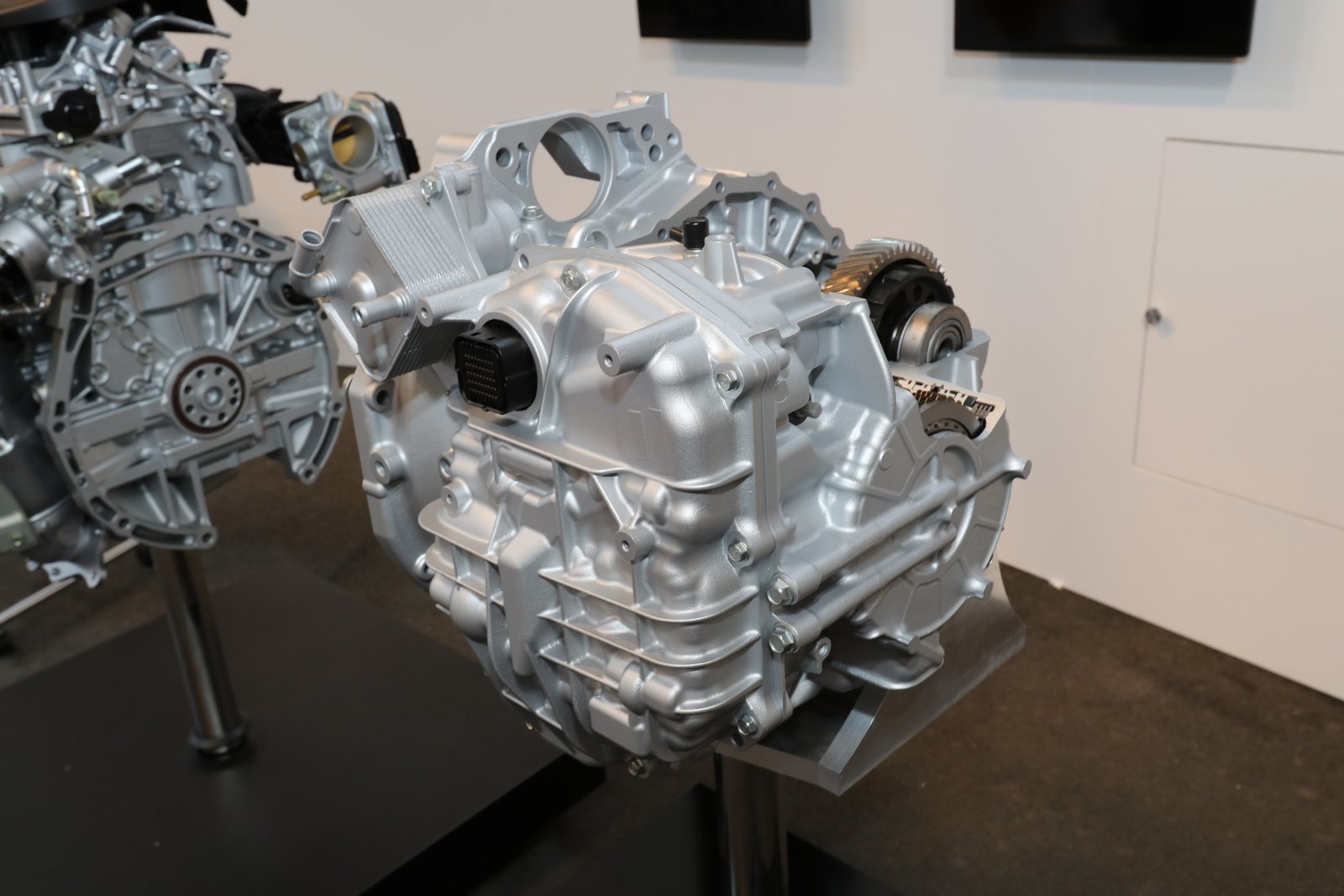Gecko
Administrator
- Messages
- 4,753
- Reactions
- 11,385
First word is out and the V6 is dropped in favor of a 2.0L turbo 4.
Fewer cylinders, more turbo | 2018 Honda Accord Powertrain Prototype First Drive

A highly camouflaged 2018 Honda Accord prototype is circling Honda's high-speed oval at its Tochigi test center, a short Shinkansen ride from Tokyo, and doing its best to replicate the bullet train's impact on spectators. There's no warning. No "I think I hear it approaching." No exhaust trumpet sneaking ahead announcing its pending arrival. Nothing. There is only the lightly rustling of leaves, a particularly annoying crow and then 1.2 seconds of fury as a 10th-generation Honda Accord prototype breaks all of the wind somewhere near 130 mph. There's a sharp gasp and the young woman to my left is wide-eyed and staring at blank space where a car used to be.
This is not the traditional way a carmaker reveals that it's eliminating a beloved naturally-aspirated 3.5-liter V6 and replacing it with a potentially lower-horsepower 2.0-liter turbocharged four-cylinder. But every once in awhile a show of force is required to show the world you can still throw down.
"No. Never in the last five years." Junji Yamano, chief engineer and leader of Accord development, confidently tells us when asked if a V6 was ever really on the table for his new midsize sedan. Through a translator, the engineer gives the same pitch every other carmaker gives when making this switch: flatter torque curve, earlier low-end power, increased fuel economy ... when not on boost.
This isn't a shock as the turbos-not-cylinders engine strategy was a significant shift for Honda that was designed to work with most, if not all, of its vehicles. If you've been paying attention recently and putting the pieces together, you'll have a correctly guessed that this is a derivative of the Ohio-built barnstormer that powers the wicked new Civic Type-R. While that engine produces 306 horses, the one in the new Accord will produce fewer, Honda confirmed. The reasons for this are pretty simple as midsize sedan buyers have different expectations of power delivery, fuel economy, and NVH; and midsize sedans have more mass to move around.
Specific changes include a low-inertia turbocharger, a secondary balancer, and tuning for regular fuel compared to the Type-R which likes the premium juice. If we had to guess on what the final spec sheet will say, we'd bet this is pushing 260 horsepower at 6,500 rpm, 255 pound-feet of torque right around 1,750 rpm, and a highway fuel economy number of 35 mpg. As the replacement for the V6, this 2.0 is certainly not the only powerplant we'll see in the upcoming Accord. Honda confirmed a hybrid variant and announced the base motor would be the company's ubiquitous 1.5-liter turbo four cylinder that does duty in the CR-V and Civic.
Backing up this motor is another semi-shared part, the 10-speed automatic we've just sampled in the all-new Odyssey. Honda wasn't ready to confirm what, if any, changes were made to the transmission itself for this application beyond a unique torque converter.
The other big news on the powertrain front is the availability of a six-speed manual with either of the two conventional engines. "Based on Civic and Type-R, we know that the characteristics of these engines are very good with a manual transmission," a Honda rep tells us; Having just stepped out of a Type-R, we couldn't argue. And because we're not accountants or profit-focused product planners, we're not going to argue with their decision to include a manual transmission at all. As expected, the Accord remains front-drive regardless of engine and transmission.
We've been warned that the prototype vehicle we're about to drive is an early build. The engine and transmission are nearing the final stages of completion, but the interior, exterior, and suspension seen here should not be taken as anything like production-ready. Considering that, we'll only talk for a moment about these things and focus on the motor in a minute.
From the outside, this Accord prototype looks longer, wider, and lower than the current car. Through the camouflage tape, the LED headlight assemblies look thin and angry. The hood looks lower than those found on almost any other production car in the post pedestrian-crash era. Finally, while it could be the camo, there's an elegance to the profile here that we think is owed to that low hood and what looks like a pushed-back dash.
Inside was a sea of, yup, you guessed it; camo. The only thing we can definitively say is that there is a ton of room on the inside. You've got excesses of height and width to work with in there that some other midsize sedans have lost as dashes, chunky door panels, and center consoles started sliding into our space.
Finally out on the track, the Accord performs almost exactly as we'd expected it to. Though we were told not to focus on it, we can't help but find the steering to be exceptional for the class. It's light on center yet requires no thought to stay in the lane and has no slop. Honda engineers admitted that behavior was one of their primary goals. The engine itself is less exemplary; it just feels, pulls, sounds and acts like every other modern turbocharged four-banger paired to a many-geared transmission.
From a dead stop with lots of pedal pressure (50-100 percent), the Accord absolutely moves. It puts you back in your seat an inch while staying sewing-machine smooth and making a great noise that's half intake and half exhaust. And when the transmission only has to upshift, the gearchanges are crisp and fast, keeping the power right where it needs to be. Acceleration doesn't really drop off until about 100 mph and then it's more of a slight drop as we hit 120 and then 125 before really thinking about it. The engine's as smooth and quiet at triple-digits as it is at 65 as it is at idle. It's pure Honda engineering talent on display. But you learn little from circling an oval in a family sedan, so we backed off and replicated some highway cruising and passing maneuvers from various real-world speeds.
These are the situations where the Accord's 2.0, just like all of the other motors of its ilk, kind of fall short. Tuned for fuel economy, as soon as you start a steady-state cruise, the transmissions leap to the highest gear possible and the engines try to use that turbo as little as possible. Prod it for a little extra momentum and you're met with a bit of a lag as the 10-speed starts dropping to find the right gear followed by a little bit more of a wait while the turbo spools up.
While these situations can seem a little annoying, there are two very real rubs to this behavior: The first is that as soon as you want to use the power, those low-load EPA fuel economy numbers get burned up and dumped right over the turbine. Second is that, after experiencing this a few times, confidence in the powertrain declines. If you need to accelerate to catch a gap in traffic or get out of a jam where it may be too late to brake, the last thing you want is noticeable, two-step delay.
The 2018 Honda Accord won't go on sale until later this year which means that Honda will have tweaked the formula to the best of its ability. Given Honda's near 70-year history of engineering excellence, if it can't crack this nut, nobody can.
Source: http://www.autoblog.com/2017/06/09/...n-prototype-first-drive-review/#slide-5066854
Fewer cylinders, more turbo | 2018 Honda Accord Powertrain Prototype First Drive

A highly camouflaged 2018 Honda Accord prototype is circling Honda's high-speed oval at its Tochigi test center, a short Shinkansen ride from Tokyo, and doing its best to replicate the bullet train's impact on spectators. There's no warning. No "I think I hear it approaching." No exhaust trumpet sneaking ahead announcing its pending arrival. Nothing. There is only the lightly rustling of leaves, a particularly annoying crow and then 1.2 seconds of fury as a 10th-generation Honda Accord prototype breaks all of the wind somewhere near 130 mph. There's a sharp gasp and the young woman to my left is wide-eyed and staring at blank space where a car used to be.
This is not the traditional way a carmaker reveals that it's eliminating a beloved naturally-aspirated 3.5-liter V6 and replacing it with a potentially lower-horsepower 2.0-liter turbocharged four-cylinder. But every once in awhile a show of force is required to show the world you can still throw down.
"No. Never in the last five years." Junji Yamano, chief engineer and leader of Accord development, confidently tells us when asked if a V6 was ever really on the table for his new midsize sedan. Through a translator, the engineer gives the same pitch every other carmaker gives when making this switch: flatter torque curve, earlier low-end power, increased fuel economy ... when not on boost.
This isn't a shock as the turbos-not-cylinders engine strategy was a significant shift for Honda that was designed to work with most, if not all, of its vehicles. If you've been paying attention recently and putting the pieces together, you'll have a correctly guessed that this is a derivative of the Ohio-built barnstormer that powers the wicked new Civic Type-R. While that engine produces 306 horses, the one in the new Accord will produce fewer, Honda confirmed. The reasons for this are pretty simple as midsize sedan buyers have different expectations of power delivery, fuel economy, and NVH; and midsize sedans have more mass to move around.
Specific changes include a low-inertia turbocharger, a secondary balancer, and tuning for regular fuel compared to the Type-R which likes the premium juice. If we had to guess on what the final spec sheet will say, we'd bet this is pushing 260 horsepower at 6,500 rpm, 255 pound-feet of torque right around 1,750 rpm, and a highway fuel economy number of 35 mpg. As the replacement for the V6, this 2.0 is certainly not the only powerplant we'll see in the upcoming Accord. Honda confirmed a hybrid variant and announced the base motor would be the company's ubiquitous 1.5-liter turbo four cylinder that does duty in the CR-V and Civic.
Backing up this motor is another semi-shared part, the 10-speed automatic we've just sampled in the all-new Odyssey. Honda wasn't ready to confirm what, if any, changes were made to the transmission itself for this application beyond a unique torque converter.
The other big news on the powertrain front is the availability of a six-speed manual with either of the two conventional engines. "Based on Civic and Type-R, we know that the characteristics of these engines are very good with a manual transmission," a Honda rep tells us; Having just stepped out of a Type-R, we couldn't argue. And because we're not accountants or profit-focused product planners, we're not going to argue with their decision to include a manual transmission at all. As expected, the Accord remains front-drive regardless of engine and transmission.
We've been warned that the prototype vehicle we're about to drive is an early build. The engine and transmission are nearing the final stages of completion, but the interior, exterior, and suspension seen here should not be taken as anything like production-ready. Considering that, we'll only talk for a moment about these things and focus on the motor in a minute.
From the outside, this Accord prototype looks longer, wider, and lower than the current car. Through the camouflage tape, the LED headlight assemblies look thin and angry. The hood looks lower than those found on almost any other production car in the post pedestrian-crash era. Finally, while it could be the camo, there's an elegance to the profile here that we think is owed to that low hood and what looks like a pushed-back dash.
Inside was a sea of, yup, you guessed it; camo. The only thing we can definitively say is that there is a ton of room on the inside. You've got excesses of height and width to work with in there that some other midsize sedans have lost as dashes, chunky door panels, and center consoles started sliding into our space.
Finally out on the track, the Accord performs almost exactly as we'd expected it to. Though we were told not to focus on it, we can't help but find the steering to be exceptional for the class. It's light on center yet requires no thought to stay in the lane and has no slop. Honda engineers admitted that behavior was one of their primary goals. The engine itself is less exemplary; it just feels, pulls, sounds and acts like every other modern turbocharged four-banger paired to a many-geared transmission.
From a dead stop with lots of pedal pressure (50-100 percent), the Accord absolutely moves. It puts you back in your seat an inch while staying sewing-machine smooth and making a great noise that's half intake and half exhaust. And when the transmission only has to upshift, the gearchanges are crisp and fast, keeping the power right where it needs to be. Acceleration doesn't really drop off until about 100 mph and then it's more of a slight drop as we hit 120 and then 125 before really thinking about it. The engine's as smooth and quiet at triple-digits as it is at 65 as it is at idle. It's pure Honda engineering talent on display. But you learn little from circling an oval in a family sedan, so we backed off and replicated some highway cruising and passing maneuvers from various real-world speeds.
These are the situations where the Accord's 2.0, just like all of the other motors of its ilk, kind of fall short. Tuned for fuel economy, as soon as you start a steady-state cruise, the transmissions leap to the highest gear possible and the engines try to use that turbo as little as possible. Prod it for a little extra momentum and you're met with a bit of a lag as the 10-speed starts dropping to find the right gear followed by a little bit more of a wait while the turbo spools up.
While these situations can seem a little annoying, there are two very real rubs to this behavior: The first is that as soon as you want to use the power, those low-load EPA fuel economy numbers get burned up and dumped right over the turbine. Second is that, after experiencing this a few times, confidence in the powertrain declines. If you need to accelerate to catch a gap in traffic or get out of a jam where it may be too late to brake, the last thing you want is noticeable, two-step delay.
The 2018 Honda Accord won't go on sale until later this year which means that Honda will have tweaked the formula to the best of its ability. Given Honda's near 70-year history of engineering excellence, if it can't crack this nut, nobody can.
Source: http://www.autoblog.com/2017/06/09/...n-prototype-first-drive-review/#slide-5066854














